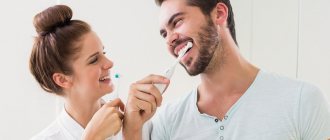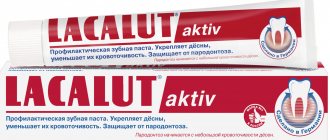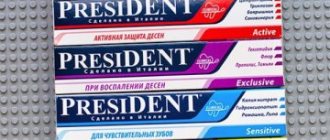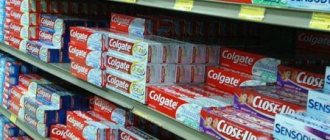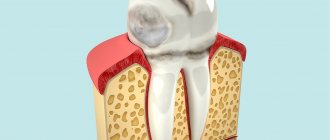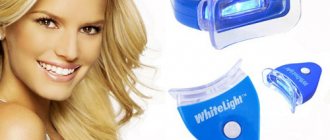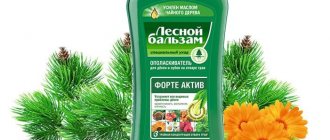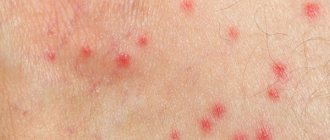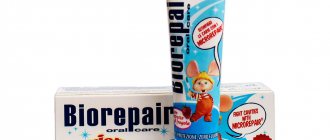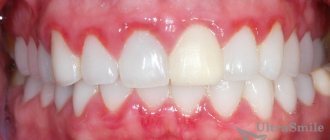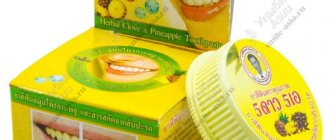Toothpaste composition Is the composition of toothpastes dangerous for oral hygiene?
Snow-white, healthy teeth are one of the external attributes of health; in light of this, oral hygiene becomes a daily necessity. In addition, dental health has a great impact on the health of internal organs, especially the heart and stomach. The pursuit of healthy teeth did not start today; Dental care has been known since ancient times. In the 30th century. BC The Chinese brushed their teeth with special flat sticks, various scrapers and metal toothpicks. Hippocrates recommended the composition of the powder in his works. Wealthy Romans had separate slaves who took care of their master's teeth, and tooth powders were made from burnt horn and coral. The compositions of dental care products in ancient times were very diverse and we would not call all substances useful. However, they prevented the appearance of plaque and caries - and this is the most important thing.
About the chemicals that are part of modern toothpastes. Should we be afraid of them? Most people, when buying toothpaste, often pay attention to the brand, price category and taste, without bothering to study the composition of the purchased product.
Samara, Volzhsky district, Kurumoch, Lopatino hygiene, Nikolaevka teeth cleaning
The most harmful chemicals contained in hygienic and medicinal toothpastes
Sodium lauryl sulfate is the substance responsible for the foaminess of toothpaste. It is usually designated surfactant or SLS and is included in the composition of washing powders and various detergents and cleaning products used by everyone, including shower gels. Surfactants have high activity. Harmful substances easily enter the body, being absorbed through the skin, and in the case of using toothpaste, through the mucous membrane. Subsequently, SLS is deposited and accumulates in vital organs, having a negative impact on their functioning. Disputes about the use of this substance have been going on for a long time and some manufacturers have replaced it with another ingredient or abandoned it completely. Most often, this surfactant is included in hygienic inexpensive toothpastes. Manufacturers add antibiotics to medicinal toothpastes as a means to fight microbes. Most often it is triclosan. Biclotymol or metronizadol are sometimes found in dental care products. Antibiotics kill harmful bacteria, but beneficial microflora also suffer. During prolonged use of toothpaste containing such serious antibacterial additives, the microflora of the oral cavity becomes poorer. In case of switching to the use of conventional pastes, exacerbation of pre-existing chronic diseases of the oral cavity is possible. Chlorhexidine, present in medicated toothpaste, is added as an antiseptic used for external use. Like antibiotics, it has a destructive effect on harmful and beneficial microorganisms. In addition, it may penetrate the stomach and intestines, so you should keep medicated toothpaste separate from children's hygiene items. Typically, Samara dentists prescribe such medicinal toothpastes for a period of no more than a week, when additional protection is required - for the period of dental prosthetics, after implantation or treatment of gum diseases - for periodontitis and periodontal disease during the healing period. In no case should you use medicated toothpastes constantly - you can change the composition of the oral microflora in such a way that pathogenic forms take the place of beneficial microorganisms. In the process of dental prosthetics, even if we are talking about technically simple metal-ceramic crowns , various manipulations are carried out with the gums. A retraction thread is inserted to form a clear gingival margin when creating a ledge, and the tooth itself is prepared. During administration, the mucous membrane may dry out because the patient has to sit for a long time with his mouth open. To avoid stomatitis or gingivitis, we recommend more careful oral hygiene and the use of medicated toothpastes and rinses.
Fluoride contained in toothpaste prevents the development of caries. At the same time, an excess of fluoride leads to the opposite effect - teeth begin to decay, and with an excessive excess, fluorosis may develop, because fluoride enters the human body along with food. It is present in cereals (oatmeal, buckwheat, rice), in fruits and vegetables, for example, in apples and grapefruits, in potato tubers. In some areas, fluoride is added to tap water that people use for cooking. Thus, the amount of fluoride in the body is often sufficient without the use of toothpaste. Dentists are usually well informed about how high fluoride levels are in the water in their area and try to inform their patients about this. In any case, in Samara the fluorine in the water is much lower than normal and there is no direct threat of fluorosis. However, medicated toothpastes with a high fluoride content should be used as prescribed by a doctor and are sold only in pharmacies.
Rules for choosing toothpaste In the absence of dental diseases, children and adults are recommended to use preventive toothpastes. The brand of paste should be changed every 2 months so as not to get used to the components of the paste. In case of pathological processes in the oral cavity, the choice of paste is agreed with the dentist. For example, when gums are irritated, pastes and rinses with anti-inflammatory and anti-edematous components are required.
Privolzhsky district why teeth are loose dentistry black plaque on teeth causes Sergievsky district gums treatment black stripes on teeth. Stavropol, Khvorostyansky district gum pain dentistry Chelno-Vershinsky, Shentalinsky district bleeding gums remove stone how to remove black plaque on teeth.
I would especially like to dwell on the use of specialized toothpastes for common diseases
Let's say that with herpetic lesions of the oral cavity, caring for teeth and gums is extremely necessary, but complicated and painful. There are medicinal pastes with an antiviral effect; finding them is difficult, but possible. The same can be said for people diagnosed with, say, trigeminal neuralgia . Touching the mucous membrane can cause a painful attack; the paste should contain neutral, non-irritating components together with medicinal ones. And here there is no time for harm to the paste itself, when the pain literally drives a person crazy. When purchasing toothpaste, each person will make his own decision. It is worth carefully studying its composition so as not to make a mistake with your choice and not harm your health. And in any case, you should listen to the opinion of your dentist, especially the one from whom you are undergoing treatment.
Like any pharmacological complex drug, medicinal toothpaste has both therapeutic and side effects. The main thing is that the first far outweighs the second and there must be a reasonable approach to everything.
You can find a list of medicinal toothpastes produced in Europe here. We tried to approach this issue professionally , taking into account the planned therapeutic effect and possible side effects.
Consequences of poor hygiene
An indicator of good oral care is the absence of plaque on the teeth and problems with the gums. The procedure for brushing your teeth helps prevent various dental problems: the development of caries, early tooth loss, periodontitis, bad breath, and it is not so important what is contained in the toothpaste - useful or not very useful substances, the main thing is that it fulfills its main purpose cleaning function. Contact with toothpaste when brushing your teeth is not so long, and the active substances in its composition are not absorbed through the mucous membrane; their molecules are quite large and are in complex combination with other substances. At the same time, failure to follow the basic rules of brushing your teeth leads to the fact that the soft plaque on the teeth crystallizes and turns into tartar. Hard formations cause the gums to separate from the neck of the tooth, causing gingivitis and subsequently periodontitis. Bacteria multiply in periodontal pockets. Scientists have identified more than 60 types of diseases that arise as a result of improper home oral hygiene:
- endocrine disorders
- digestive tract dysfunction
- nervous disorders
- renal pathology
- cardiovascular disorders
- rheumatism
Active reproduction of pathogenic flora leads to the formation of a chronic focus of infection in the mouth. This affects the functioning of the body's defenses and leads to damage to various internal organs. Therefore, general oral hygiene is essential to maintaining a white smile and overall health.
The first signs of enamel destruction
It is necessary to protect teeth preventively, however, when the very first signs of tooth enamel hypoplasia
, urgent mobilization is required. You can recognize the beginning of the process by the white chalky spots that appear on the surface of the tooth. The second symptom is tooth sensitivity. The so-called reaction to cold and hot. At this stage, it is necessary to replace a simple preventive paste for everyday home hygiene with a therapeutic one, which will strengthen the tooth enamel. However, you should still consult your dentist before use.
Prevention of oral diseases
Tooth and gum diseases can be prevented by regular oral hygiene. When rinsing with warm water after each meal, add a drop of lemon juice to the water. Hydroalcoholic extracts of medicinal plants are useful - for example, chamomile and calendula. Chew your food thoroughly...Solid foods naturally massage and strengthen your gums, improve circulation and reduce the risk of oral disease. Many microorganisms live in the mouth. If oral hygiene is not observed, teeth, gums and mucous membranes hurt. The infection spreads throughout the body, penetrates the internal organs, causes arthritis, hearing impairment, and smell impairment. Microbial waste enters the bloodstream, placing increased stress on the kidneys, heart, and digestive system. Caries is the softening and destruction of tooth tissue, causing a cavity to form inside the tooth. The exact cause of the disease is unknown, the most likely are hereditary predisposition, abuse of sweets, baked goods, deficiency of calcium, fluorine, phosphorus, poor oral hygiene, which slows down the development of caries.
Gingivitis affects the gums, the development of pathology is facilitated by dysfunction of the endocrine system, malocclusion railway siding Razinsky
The gums are itchy, swollen, and there is bleeding between the teeth. The shape of the wounds is bad. The treatment uses antiseptic rinsing solutions and scrapes off periodontal pockets. Stomatitis. The inflammatory process in the mucous membrane often develops after measles and viral diseases. Triggered by vitamin deficiency, general intoxication, diseases of the digestive, endocrine, nervous system, disorders, and inappropriate oral hygiene. Stomatitis develops after mechanical damage to the mucous membrane, the wound turns into a non-healing ulcer. The gums hurt, swell and bleed, with a characteristic white color... The disease is treated with antiseptics, taking multivitamins in the villages of Novoorenburgsky, Sosnovka
Halitosis (bad breath)
The reason is excessive proliferation of microorganisms, the disease develops with insufficient hygiene of the oral cavity, base of the tongue, palate, caries, when it is difficult or impossible to thoroughly clean the affected area, removal of food debris, insufficient salivation, which naturally cleanses the oral cavity. An unpleasant odor occurs during periods of exacerbation of chronic diseases of the ENT organs, gastrointestinal tract, increased levels of female hormones - they cause desquamation of the epithelium of the mucous membrane and increase the population of microorganisms that emit hydrogen sulfide in the villages of Aleksandrovka, Verkhnepecherskoye, Vladimirovka. Tartar forms compactions of plaque that is deposited where the tooth contacts the gums and in the spaces between teeth. Dental plaque consists of food particles, mucus, and pathogenic microorganisms. The color is gray or dirty yellow; in smokers it is dark or black. Tartar can cause the development of gingivitis, and later periodontitis. The deposits are removed in the dentist's office using a special ultrasound machine. Periodontitis... The tissues surrounding the tooth are inflamed. There is a burning sensation, itching, tingling in the gums, redness or cyanosis, swelling as if creeping along the tooth, and bad breath, Kanuevka village,
village of Plodosovkhoz. On the other hand, as the disease progresses, the gums slide down, exposing the neck of the tooth and releasing pus and blood when squeezed. Over time, teeth become loose and fall out. Pokrovka village, Sretenka village;
Rural settlement Kupino. The disease occurs after 30 years of age, its causes are a lack of vitamins P and C, endocrine system disorders, tartar, non-healing caries, malocclusion, inappropriate oral hygiene Nizhneobrocheno, Novonatalino, Potulovka
Hydrogen peroxide for oral hygiene
It is believed that one of the causes of caries and periodontitis are food particles that remain in the oral cavity. In fact, rotting food particles rarely cause caries - teeth are destroyed when eating modern food Prepolovenka village, Ekonomiya village;
Rural settlement Priboy. Eskimos, representatives of island tribes, never brush their teeth or buy modern products, but many “civilized” people envy the health of their oral cavity. Proponents of the treatment advise regular oral hygiene with 3% peroxide mixed with food or non-fluoride toothpaste; After brushing your teeth, rinse your toothbrush with peroxide; In the morning and after lunch, rinse your mouth with a 3% solution of peroxide and water. For diseases of the mucous membranes - ulcers, inflammation - rinsing with this hygienic product is also used. With ENT diseases, mucus (snot) accumulates in the nasal passages, and an infection develops - the cause of the stench.
Recipe for getting rid of bad breath
Dilute 15 drops of 3% peroxide in a tablespoon of water. Apply twice daily into each nostril. Home remedies for the oral cavity Chelno-Vershinsky, Shentalinsky district Toothache. Rinse your mouth with a warm decoction of sage and yarrow for a long time - hold the liquid in your mouth for several minutes. Using chewing gum, fix a piece of camphor on the sore tooth. Mix 2 parts oregano, 2 parts Hypericum perforatum, 4 parts. Boil 300 ml of boiling water for 3 seconds. Mix the mixture, simmer over low heat for 2 minutes, leave for 2 hours, strain. Use for oral hygiene, remove unpleasant odor 2-3 times a day Stavropol, Khvorostyansky district Stomatitis. Perform oral hygiene by rinsing with a seven-day infusion. Wash and chop fresh grass, 2 l. pour a glass of sea buckthorn oil, leave in a cool, dark place for two days, strain. Lubricate the oral mucosa several times a day. Boil 1 tbsp. Hypericum perforatum and 1c. L. Pour a glass of boiling water over chamomile, leave for half an hour, strain. Rinse your mouth if you have diseases of the mucous membranes. It is useful to chew fresh parsley - it is an excellent antiseptic and promotes wound healing. Take orally a mixture of fresh juice and potatoes (2 c. L. four times a day), as well as a mixture of parsley juice and potatoes (3 c. L. 1 time a day)
Biomed biocomplex
It is difficult to say how much benzyl alcohol (Benzyl Alcohol) is in this paste - only the manufacturer knows about this. But if it is less than 1%, it is not dangerous. The paste does not contain fluoride.
Ingredients: Aqua, Hydrogenated Starch Hydrolysate, Dicalcium Phosphate Dihydrate, Hydrated Silica, Glycerin, Sodium Coco-Sulfate, Cellulose Gum, Salvia Officinalis (Sage) Leaf Extract, Sodium Benzoate, Potassium Sorbate, Zinc Citrate, Aroma, Chamomilla Recutita Flower Extract , Benzyl Alcohol , Tetrasodium Glutamate Diacetate, Sodium Bicarbonate, Populus Tremuloides Bark Extract, Polysorbate 80, Xanthan Gum, Decyl Glucoside, Menthol, Menthyl Lactate, Hydroxyapatite, Rosa Canina Fruit Oil, Tocopherol, Linum Usitatissimum Seed Oil, Arginine, Copper Chlorophyll Extract (Cl 75810 ), Trans-Anethole, Eucaliptus Globulus Leaf Oil, Rosmarinus Officinalis Leaf Oil, Betula Verrucosa Leaf Extract, Plantago Major Extract, Stevia Rebaudiana Extract, Salvia Officinalis Leaf, Cedrus Atlantica Wood Oil, D-Limonene.
Eliminate bad breath
Rinse your mouth with 3% 3-4 times a day. 50 g of horseradish root, wash and peel the minced meat, pour in a glass of vodka, leave for 3 days, strain. Add a few drops to a glass of warm water and rinse your mouth. Folk remedies with antiseptic and anti-inflammatory effects, urban settlement Bezenchuk. Grind fresh horseradish root in a blender and squeeze out the juice through cheesecloth. Add to warm water and rinse your mouth several times a day. Grind 3c l leaves, 1c. l. Boil calendula flowers in two glasses of boiling water, simmer for 10 minutes in a water bath, let cool, strain. Use to rinse. Rinse your mouth with fresh cabbage juice diluted with the same amount of warm water. Gingivitis, periodontitis. Massage your gums with fir oil. Mix 3 parts oak bark, 2 parts linden blossom, brew 1c. L. Pour a glass of boiling water over the mixture, leave for 20 minutes, strain. Use to rinse. Folk remedies for wounds and ulcers. Boil 2 liters of crushed leaves with a glass of boiling water, leave for 15 minutes, strain. Rinse your mouth with warm infusion. Boil 1 liter of marsh grass with a glass of boiling water, leave for 45 minutes, strain. Rinse your mouth to heal the mucous membrane of the Privolny village.
- treat tooth Pridorozhny, Rassvet, Roshchino, Rivne-Rozhdestveno, Rybachy,
Sensodyne
The presence of polyethylene glycol (PEG-8) and carbomer hardly makes this paste healthy for teeth. Mass fraction of fluoride - 1450 ppm (permissible dose).
Ingredients: Glycerin, PEG-8 , Silica, Calcium Sodium Phosphosilicate (NOVAMIN®), Cocamidopropyl Betaine, Sodium Methyl Cocoyl Taurate, Sodium Monofluorophosphate , Aroma , Titanium Dioxide, Carbomer , Sodium Saccharin, Limonene.
Blend-a-med 3D white
Disodium Pyrophosphate (sodium pyrophosphate) - is also used as a food additive. It improves the consistency of the product, increases moisture-binding and emulsifying ability. Excessive consumption of this substance impedes the process of calcium absorption, as a result of which calcium and phosphorus are deposited in the kidneys.
Cl 74260 is a green pigment that can be used in any cosmetic products, except those intended for the skin around the eyes. According to some reports, the substance can cause serious birth defects in the development of embryos.
The mass fraction of sodium fluoride (Sodium Fluoride) is not indicated, so it can be assumed that it contains less than 0.1%, that is, a safe amount. At the same time, SLS and carbomer are present among the ingredients.
Ingredients: Aqua, Hydrated Silica, Sorbitol, Disodium Pyrophosphate , Sodium Lauryl Sulfate , Cellulose Gum, Aroma , Sodium Hydroxide , Carbomer , Sodium Saccharin, Sodium Fluoride , Xanthan Gum, Limonene, Cl 74260 .
Making your own tooth powder at home
You can make your own tooth powder. A homemade product will definitely be natural and, accordingly, harmless and even useful.
The recipe may contain the following components:
- 2 tablespoons of baking soda;
- 1 tablespoon ground turmeric.
- 60 g white clay;
- 1-2 tablespoons of Himalayan salt;
- Essential oil of tea tree, mint, orange;
After thoroughly mixing all the ingredients, the powder can be used.
Aquafresh refreshing mint
In addition to the ubiquitous SLS and polyethylene glycol (PEG-6), this paste contains two dyes.
Cl 73360 is a little-studied synthetic red dye; allergic reactions are possible; carcinogenicity has not been established. May accumulate in the body. There are suspicions that it may have a negative impact on the environment.
Cl 74160 is a blue pigment belonging to the group of phthalocyanine dyes. There is evidence that phthalocyanines can cause serious birth defects in the development of embryos.
The mass fraction of fluoride is within the norm - 1450 ppm.
Ingredients: Aqua, Hydrated Silica, Sorbitol, Glycerin, Sodium Lauryl Sulfate , Xanthan Gum, Aroma , Titanium Dioxide, PEG-6 , Sodium Fluoride, Sodium Saccharin, Carrageenan, Limonene, Cl 73360 , Cl 74160 .
"Forest balm" daily care
Phenoxyethanol is a preservative with a medium level of danger; it exhibits synergistic action with parabens, quaternary ammonium compounds and sorbic acid. According to EU Regulations, it is included in the list of preservatives permitted for use in concentrations up to 1%.
Contains SLS, the irritant Sodium Hydroxide and two potentially dangerous allergenic dyes. The permissible proportion of fluorides is 0.1% by weight of the product.
Ingredients: Aqua, Silica, Sorbitol, Sodium Lauryl Sulfate , Aroma , Cellulose Gum, Aloe Barbadensis Leaf Juice, Camellia Sinensis Leaf Extract, Abies Sibirica Leaf Extract, Urtica Dioica (Nettle) Leaf Powder, Chamomilla Recutita (Matricaria) Flower, Achillea Millefolium Extract , Hypericum Perforatum Flower/Leaf/Stem Extract, Chelidonium Majus Extract, Sodium Monofluorophosphate, Sodium Fluoride, Sodium Saccharin, Sodium Chloride, Glycerin, Propanediol, Sodium Hydroxide, Citric Acid, Phenoxyethanol , Benzyl Alcohol , Sodium Benzoate, Potassium Sorbate, Sodium Sulfate, Sodium Sulfite, Linalool, Cl 19140 , Cl 42090 .
MARVIS
The most expensive pasta of those listed here costs about 1000 rubles. I included it in the review because MARVIS toothpaste, or rather the brand, has many fans. That's why it's especially important to look at its composition, which contains nothing remarkable. And yes, there is SLS.
Ingredients: Glycerin, Aluminum Hydroxide, Aqua (Water/Eau), Silica, Aroma (Flavor) , Cellulose Gum, Titanium Dioxide, Sodium Lauryl Sulfate , Sodium Saccharin, Sodium Citrate, Citric Acid, Eugenol, Limonene, Benzyl Alcohol .
SPLAT "Biocalcium"
SPLAT has begun to improve the composition of its pastes; for example, they no longer contain SLS, but polyethylene glycol (PEG-8) can still be found in some pastes. This is not very good, I hope the manufacturer continues to improve the formulations. Please note that SPLAT “Biocalcium” paste contains the animal-derived ingredient Omega-3-Fish Oils - this is important for vegans. The product does not contain fluoride, but it is added to some other toothpastes of this brand.
Ingredients: Hydrogenated Starch Hydrolysate, Hydrated Silica, Aqua, PEG-8 , Sodium Coco-Sulfate, Cellulose Gum, Aroma , Calcium Lactate, Titanium Dioxide, Sodium Bicarbonate, Hydroxyapatite, PVP, Sodium Methylparaben, Sodium Saccharin, Omega-3-Fish Oils , Papain, Limonene.
“New pearls” with aloe juice
Cl 42051 is a synthetic blue or violet dye (E131), banned in some countries (Australia, Norway, USA). It is used to color soda and some medicines. Potential dangers: asthma, gastrointestinal upset, allergic reactions.
This dye is not alone here - with it are Cl 19140 and Cl 42090, which I talked about at the beginning of the article and which are used in some other pastes. Sodium lauryl sulfate is also present. Mass fraction of fluoride - 500 ppm (0.05%).
Ingredients: Sorbitol, Hydrated Silica, Aqua, Potassium Citrate, Aloe Barbadensis Gel, Sodium Lauryl Sulfate , Aroma , Xanthan Gum, Sodium Benzoate, Sodium Monofluorophosphate, PVP, Potassium Sorbate, Carbomer , Sodium Saccharin, Sodium Sulfate, Sodium Chloride, Cl 19140 , Cl 42051 , Cl 42090 .
INNOVA Sensitive
It contains polyethylene glycol and Disodium EDTA (ethylenediamineacetic acid), which poses an environmental hazard because it accumulates in groundwater. It is surprising that this substance is still used, because it can easily be replaced, for example, with phytic acid, obtained from rice husks.
The normal fluoride content is 1100 ppm.
Ingredients: Aqua, Sorbitol, Hydrated Silica, Glycerin, PEG-8 , Hydroxyapatite (nano), Calcium Lactate, Aroma , Sodium Monofluorophosphate , Cellulose Gum, Cocamidopropyl Betaine, Sodium Lauroyl Sarcosinate, Xylitol, Propylene Glycol (and) Olaflur, Sodium Methylparaben, Stevia Rebaudiana Extract, Anethole, Citric Acid, Eucalyptol, o-Cymen-5-ol, Tocopheryl Acetate, Titanium Dioxide, Thymol, Vitis Vinifera (Grape) Seed Extract, Disodium EDTA , Tannase, Limonene, Linalool, Citral.
Organic People Zoom 3 White
The toothpaste is labeled COSMOS Organic. It contains natural plant components, some of which are of organic origin. The source of fragrance (Aroma) is not specified.
Ingredients: Sorbitol, Silica, Glycerin (organic), Aqua, Cocamidopropyl Betain, Cellulose, Polygonum Fagopyrum (Buckwheut) Flower, Hydrogenated Castor Oil, Simmondsia Chinensis (Jojoba) Seed Extract (jojoba extract), Algin, Aloe Barbadensis Leaf Extract (organic extract) Aloe Vera), Organic Mentha Piperita Essential Flower-Leaf-Stem Oil (Organic Peppermint Essential Oil), Disodium Rutinyl Disulfate (Vitamin P), Papain, Menthol, Xanthan Gum, Aroma, Sodium Benzoate, Potassium Sorbate, Citric Acid. CI 77492, CI 77289.
"Grandmother Agafya's Recipes"
Another certified paste with the ICEA label. The composition is impressive - the product contains many organic plant components. True, in this case the source of the fragrance (Parfume) is also not indicated.
Ingredients: Aqua, Glycerin, Calcium Carbonate, Silica, Xylitol, Sodium Lauroyl Sarcosinate, Xanthan Gum, Carrageenan, Melissa Officinalis Flower/Leaf/Stem Water (organic lemon balm extract), Hippophae Rhamnoides Fruit Oil (organic sea buckthorn oil), Althaea Officinalis Root Extract (Organic Marshmallow Root Extract), Urtica Dioica Leaf Extract (Organic Stinging Nettle Extract), Rosa Canina Fruit Oil (Organic Rosehip Oil), Lavandula Angustifolia Oil (Organic Lavender Oil), Hypericum Perforatum Flower Extract (Organic St. John's Wort Extract), Salvia Officinalis Leaf Water (Organic Sage Distillate), Mentha Piperita Leaf Water (Organic Mint Extract), Arctium Lappa Root Extract (Organic Burdock Extract), Saponaria Officinalis Plant Extract (Organic Soapwort Extract), Achillea Millefolium Flower Water (Organic Yarrow Extract), Chamomilla Recutita Flower Extract (organic chamomile extract), Aesculus Hippocastanum Leaf Extract (organic horse chestnut extract), Sodium Benzoate, Potassium Sorbate, Caramel, Parfume, Limonene (natural component from essential oils).
Natura Siberica “Frost berries”
Frosty Berries toothpaste contains a lot of extracts and does not contain any potentially dangerous ingredients. As for the dye, CI 75470 is carmine, derived from carminic acid. Carminic acid is extracted from cochineal - female insects of the cactus false scale insect Coccus cacti or Dactylopius coccus. The insects are collected, dried, crushed, treated with ammonia and filtered. Carmine is not toxic, does not cause allergies and is not a carcinogen, however, there are people for whom it is important to know that the component is obtained from insects.
Ingredients: aqua with infusions of Sorbus Sibirica Extract (Siberian mountain ash extract), Larix Sibirica Needle Extract (Siberian larch extract), Juniperus Sibirica Needle Extract (Siberian juniper extract), Crataegus Monogina Flower Extract (organic hawthorn extract), Empetrum Sibiricum Extract (extract Siberian shiksha); Ribes Nigrum Leaf Extract (Organic Blackcurrant Extract), Rubus Idaeus Fruit Extract (Organic Raspberry Extract), Rubus Chamaemorus Fruit Extract (Cloudberry Extract), Glycerin, Silica, Sodium Coco-Sulfate, Calcium Glycerophosphate, Vaccinium Macrocarpon (Cranberry) Seed Oil (Cranberry Seed Oil), Hippophae Rhamnoides Fruit Oil (Sea Buckthorn Oil), Cellulose Gum, Papain, Pineamidopropyl Betaine, Hippophae Rhamnoidesamidopropyl Betaine, Sodium Cocoyl Glutamate, Zinc Citrate, Sodium Saccharin, Aroma, Citric Acid, Sodium Benzoate, Potassium Sorbate, CI 75470.
Parodontax "Extra Fresh"
Toothpaste contains a permissible dose of fluoride - 1400 ppm. Apart from the fragrance, the origin of which is unknown, the product does not contain critical components.
Ingredients: Sodium Bicarbonate, Aqua, Glycerin, Alcohol, Cocamidopropyl Betaine, Krameria Triandra Extract, Echinacea Purpurea Flower/Leaf/Stem Juice, Aroma , Xanthan Gum, Chamomilla Recutita Extract, Commiphora Myrrha Extract, Sodium Fluoride, Sodium Saccharin, Sodium Benzoate, Salvia Officinalis Oil, Mentha Piperita Oil, Mentha Arvensis Oil, Limonene, Linalool, Cl 77491 (iron oxide).
Colgate Sensitive Pro-Relief
And again it contains SLS - probably the most popular component of mass-market toothpastes. Mass fraction of fluoride - 1450 ppm (permissible dose).
Ingredients: Calcium Carbonate, Aqua, Sorbitol, Arginine, Sodium Lauryl Sulfate , Aroma , Sodium Monofluorophosphate , Cellulose Gum, Sodium Bicarbonate, Tetrasodium Pyrophosphate, Sodium Saccharin, Benzyl Alcohol , Xanthan Gum, Limonene, Cl 77891 (titanium dioxide).
ROCS “Morning Energy”
Chloride Magnesium (magnesium chloride) belongs to the third hazard class (moderately hazardous substances) and has aggressive corrosive properties. This substance is registered as a food additive E511.
Please also pay attention to unwanted SLS, methyl and propylparaben in the composition.
Ingredients: Aqua, Silica, Glycerin, Xylitol, Sodium Lauryl Sulfate , Xanthan Gum, Aroma , Calcium Glycerophosphate, Bromelain, Sodium Saccharin, Methylparaben , Titanium Dioxide, Propylparaben , Chloride Magnesium .
